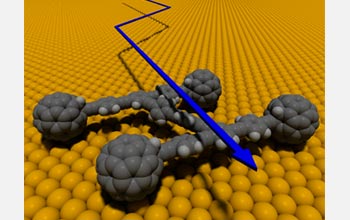Multimedia Gallery
Nano-car has no engine under the hood, but rolls on wheels 5,000 times smaller than a human cell.
James Tour and coworkers at Rice University synthesized a molecular car with four carbon-based wheels that roll on axles made from linked carbon atoms. The nano-car's molecular wheels are 5,000 times smaller than a human cell. A powerful technique that allows viewing objects at the atomic level called scanning tunneling microscopy reveals the wheels roll perpendicular to the axles, rather than sliding about like a car on ice as the car moves back and forth on a surface.
Credit: Y. Shirai/Rice University
Images credited to the National Science Foundation, a federal agency, are in the public domain. The images were created by employees of the United States Government as part of their official duties or prepared by contractors as "works for hire" for NSF. You may freely use NSF-credited images and, at your discretion, credit NSF with a "Courtesy: National Science Foundation" notation.
Additional information about general usage can be found in Conditions.
Also Available:
Download the high-resolution JPG version of the image. (2.4 MB)
Use your mouse to right-click (Mac users may need to Ctrl-click) the link above and choose the option that will save the file or target to your computer.
Related story: "Fantastic Voyage" Not So Far-fetched



